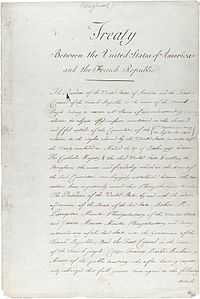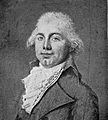Louisiana Purchase facts for kids
Quick facts for kids Louisiana PurchaseVente de la Louisiane |
|||||||||||
|---|---|---|---|---|---|---|---|---|---|---|---|
| Expansion of the United States | |||||||||||
| 1803–1804 | |||||||||||
 Modern map of the United States overlapped with territory bought in the Louisiana Purchase (in white) |
|||||||||||
| History | |||||||||||
|
• Established
|
4 July 1803 | ||||||||||
|
• Disestablished
|
1 October 1804 | ||||||||||
|
|||||||||||
| Today part of | |||||||||||
The Louisiana Purchase (French: Vente de la Louisiane, lit. 'Sale of Louisiana') was a huge land deal in 1803. The United States bought a massive amount of land from France. This land, called the Louisiana Territory, cost $15 million. That's about $293,133,333 in today's money.
The purchase nearly doubled the size of the United States. It stretched from the west side of the Mississippi River all the way to the Rocky Mountains. It went north to the Canadian border and south to the Gulf of Mexico. The important city of New Orleans was also part of this deal.
Contents
Why the Louisiana Purchase Happened
The land in the Louisiana Purchase was first controlled by France in 1699. Then, in 1762, France gave the land to Spain. But in 1800, French Emperor Napoleon Bonaparte bought it back from Spain. Before the purchase, Americans only controlled the area east of the Mississippi River and north of New Orleans.
America was growing very fast. Settlers needed more space to live and farm. The U.S. also really wanted to own New Orleans. This city had a major port that was perfect for shipping goods. Products could travel up and down the Mississippi River. The port was also key for trading with other countries.
How the Purchase Was Negotiated
President Thomas Jefferson heard that Napoleon wanted to keep the Louisiana Territory. He thought Napoleon planned to build a French empire in America. Jefferson sent Robert R. Livingston to France. His job was to buy just New Orleans for $10 million.
However, Napoleon had many war debts from the Great French War. He also thought selling the land to the U.S. would upset England, his enemy. So, Napoleon offered to sell the entire Louisiana Territory. He asked for just $5 million more than the original offer for New Orleans.
The U.S. Senate approved the treaty to buy the land in October 1803. The American flag was raised over New Orleans on December 20, 1803.
Concerns About the Purchase
Many people in the U.S. Congress had worries about this big land deal:
- Some said the U.S. Constitution did not say the government could buy land from another country.
- They feared Spain would be angry and want the land back. Spain might also worry that Napoleon would use the money to continue his wars.
- Congress wondered what would happen to the people already living there. This included French, Mexican, and Spanish people. Would they become U.S. citizens? About 60,000 non-native people lived there. About half of them were enslaved people.
- There was concern that settlers moving so far west might not stay loyal to the United States.
- The issue of slavery was a big problem. The North and South already disagreed about it. What would happen to the enslaved people in the new territory?
Jefferson's Solutions to Concerns
President Jefferson had answers for these worries:
- The Constitution did not mention buying land. So, Jefferson used his power to make treaties. Article II, Section 2, of the Constitution lets the president negotiate treaties. This is what Jefferson did.
- Spain was indeed angry. But James Madison reminded them that the U.S. had first asked Spain to buy the land. Spain had told the U.S. to deal with France. So, Spain no longer had rights to the land.
- Congress made temporary rules for the local government. Things would continue as they had under French and Spanish rule. The president could also use the military to keep order.
- The military would help keep peace. The government would also learn more about the land and map it. This would help them control it.
- As parts of the territory became states, they could decide for themselves about slavery.
Exploring the New Land
President Jefferson knew he needed to learn more about the land he bought. He sent explorers to map the country west of the Mississippi River. This would help settlers move there and be governed well.
The most famous trip was the Lewis and Clark Expedition. It was led by Meriwether Lewis and William Clark. They left Saint Louis, Missouri, in 1804 with 33 people. They reached the Pacific Ocean in 1806. Along the way, they met several Native American tribes. A Shoshone woman named Sacagawea helped guide them for part of their journey.
Another trip was the Red River Expedition in 1806. This was one of the first science trips to explore the Southwestern United States. Its goal was to find and map the start of the Red River. This river was a possible trade route to Santa Fe, which was then controlled by Spain.
The Pike Expedition was led by United States Army Lieutenant Zebulon Pike. This was the first official American effort to explore the western Great Plains and the Rocky Mountains in today's Colorado. Pike met several Native American tribes. He told them that the U.S. now claimed their land.
Impact on Native Americans
The Louisiana Purchase was made between France and the United States. The many Indian tribes living on the land were not included in the talks. They had not given their land to anyone. For 40 years after the purchase, the U.S. government worked to move many tribes from their lands east of the Mississippi. This led to sad events like the Trail of Tears.
Interesting Facts About the Louisiana Purchase
- René-Robert Cavelier, Sieur de La Salle explored the Mississippi River by canoe. He named the Mississippi basin "La Louisiane" (Louisiana) after King Louis XIV. He claimed it for France.
- The Louisiana Purchase was the first time the United States gained territory by signing a treaty with another country.
- The land cost the United States about 3 cents per acre. This was an amazing price!
- When Napoleon got the land back from Spain, he secretly wanted to rebuild a French empire in America. He changed his mind because he needed money to fight wars in Europe.
- Some historians believe that Napoleon Bonaparte did not have the right to sell the French-owned land to the United States.
- Napoleon’s brothers, Joseph and Lucien, found out about his plans. They tried to convince him not to sell Louisiana.
- The treaty did not clearly state the exact borders of the land. President Jefferson quickly sent expeditions to explore and mark the boundaries.
- The new land was rich in valuable resources like gold, silver, and many other ores.
Images for kids
-
1804 map of "Louisiana", bounded on the west by the Rocky Mountains
-
The future president James Monroe helped Robert R. Livingston negotiate the Louisiana Purchase.
-
Transfer of Louisiana by Ford P. Kaiser for the Louisiana Purchase Exposition (1904)
-
Flag raising in the Place d'Armes of New Orleans, marking the transfer of French Louisiana to the United States, December 20, 1803.
-
Plan of Fort Madison, built in 1808 to establish U.S. control over the northern part of the Louisiana Purchase, drawn 1810.
-
Louisiana Purchase territory shown as American Indian land in Gratiot's map, 1837.
See also
 In Spanish: Compra de Luisiana para niños
In Spanish: Compra de Luisiana para niños









